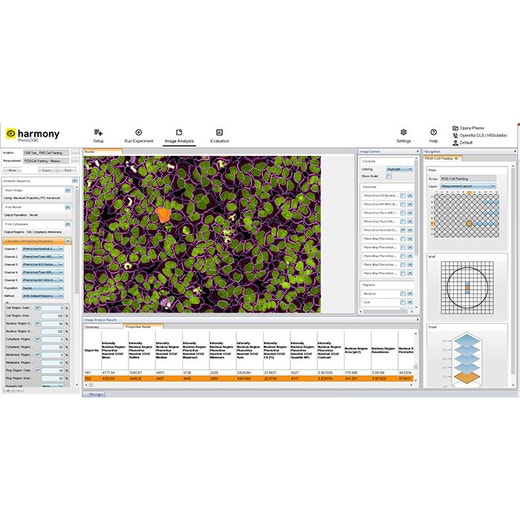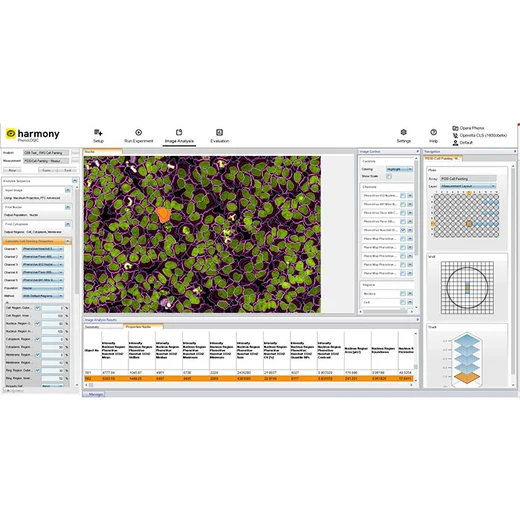
Harmony High-Content Imaging and Analysis Software


Harmony High-Content Imaging and Analysis Software


Harmony High-Content Imaging and Analysis Software


Designed for Revvity high-content screening systems, Harmony™ software supports analysis of the most complex cellular models in 3D and reliably discriminates phenotypes, turning your biological data into knowledge. The workflow-based user interface guides you through the entire process.
- Analyze common assays with more than 30 ready-made solutions, or create your own with simple image-analysis building blocks
- Visualize and analyze your samples in 3D for greater depth of information and insights in a more physiologically relevant context
Our latest version, Harmony 5.3, enhances image data handling performance and provides intuitive, powerful search functionality.
Product information
Overview
Designed for biologists, Harmony’s workflow-based interface makes the whole process of high-content analysis straightforward, even for new users with little microscopy or programming knowledge.
One high-content analysis software for all your applications
- Phenotypic Screening
- Get robust phenotypic fingerprints based on intensity, morphology, texture and fluorescence distribution parameters
- Easily train the software to recognize relevant phenotypes
- Quantify even subtle phenotypic differences
- Live Cell Imaging
- Follow phenotypic changes over time
- Accurately quantify label-free live cell images
- Track individual cells over time or analyze wound-healing assays
- Analyze cell signaling dynamics using e.g. FRET based assays
- Perform fast response assays such as calcium flux or cardiomyocyte beat rate with imaging frame rate of up to 100fps.
- Set-up "dispense and read" assays on the Opera Phenix Plus system with liquid handling module
- Enhance your live-cell assay capabilities through improved time-series flexibility
- 3D Cell Models
- Speed up 3D image acquisition by targeted imaging of microtissues
- Better understand your cell models by exploring them in the new 3D viewer and the XYZ viewer
- Measure morphologies and volumes in 3D, count nuclei within spheroids
- Enhance Maximum Intensity Projection Analysis using PlaneMap
- One software for image acquisition, 3D visualization and analysis
- Rare Cell Phenotypes
- Quickly capture your rare cell phenotypes with PreciScan™
- Pre-screen at low resolution and acquire objects of interest at high resolution
- Shorten your image acquisition times
- Reduce your data volume
- Routine Assays
- Utilize more than 30 ready-made-solutions for standard assays
- Ensure repeatability by running established protocols
- Optional module
- Phenologic.AI offers an efficient and reliable method for identifying cells and cellular nuclei within fluorescent and brightfield images by harnessing the power of pre-trained deep neural networks (DNNs).
One high-content analysis software for all users
- New Users
- Get quantification for your cell images
- Easy to learn – even for users with little microscopy or programming knowledge
- Get started with 30 ready-made solutions
- Logical workflow for easy control of all aspects of image acquisition and analysis
- Simple building blocks to assemble image analysis sequences (step-by-step)
- Expert Users
- Quantify difficult phenotypes with advanced texture and morphology readouts
- Utilize advanced building blocks to enable e.g. ratiometric FRET imaging
- Create “stitched” global images from multiple fields of view
- Examine samples at multiple scales – regions found in the global image can be used for analysis in the original images
- For Lab Managers
- Keep up with increasing research needs – analyze larger sample sizes
- Quickly train new users to set up the instrument and analyze their images
- Find images, metadata and results quickly via the integrated sortable database
- View and analyze data from any computer with installation of Harmony software
- Get application support by image analysis experts
Specifications
| Instrument Compatibility |
Opera
Opera Phenix Plus
Operetta CLS
|
|---|---|
| Unit Size |
1 each
|
Resources
Are you looking for resources, click on the resource type to explore further.
Mitochondrial dynamics are essential for energy conversion and neuron survival. Understanding changes in mitochondrial dynamics is...
Liver toxicity remains one of the main reasons for drug failure in clinical trials. Improving preclinical toxicity testing is a...
The promise of high-content screening is the acceleration of discovery by extracting as much relevant information as possible from...
Dysregulation of GPCR signaling, particularly calcium signaling, has been implicated in different diseases, e.g. cancer and...
Drug-induced cardiotoxicity is a frequent cause of drug attrition during drug development and can lead to the withdrawal of drugs...
Combining CRISPR gene editing and cell painting provides researchers with the ability to correlate genotypes with phenotypes and...
Loading...


How can we help you?
We are here to answer your questions.






























